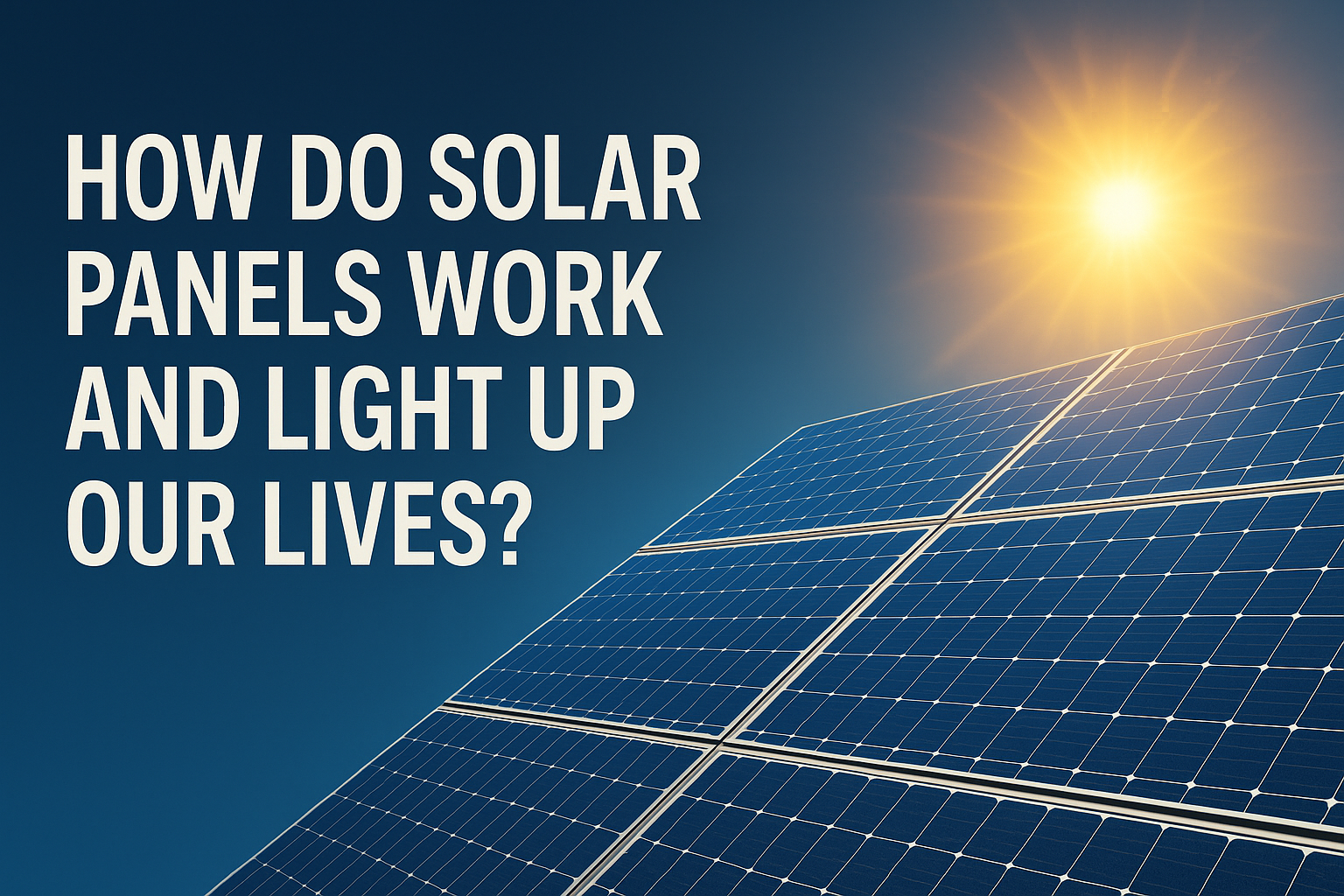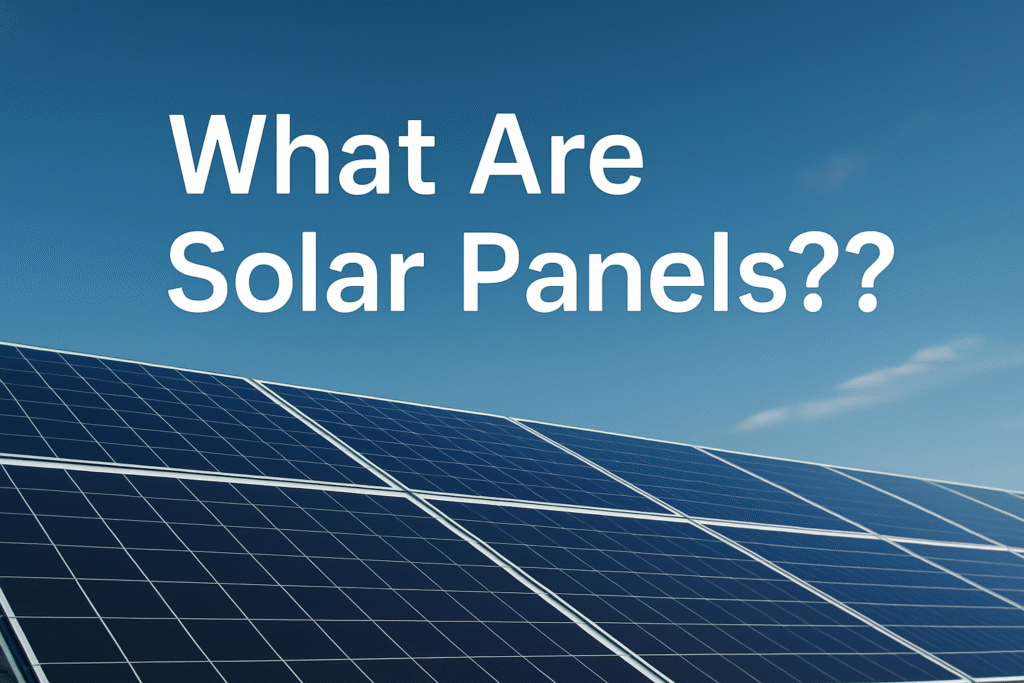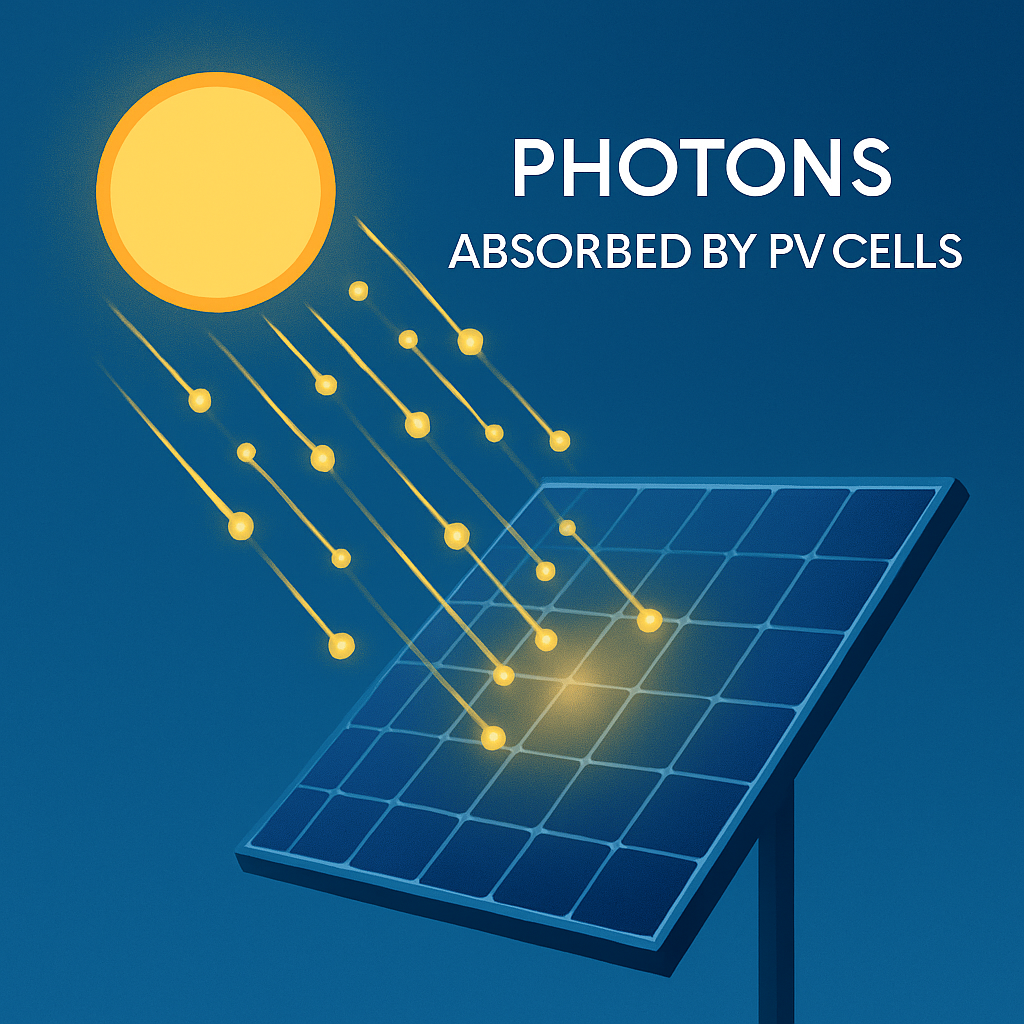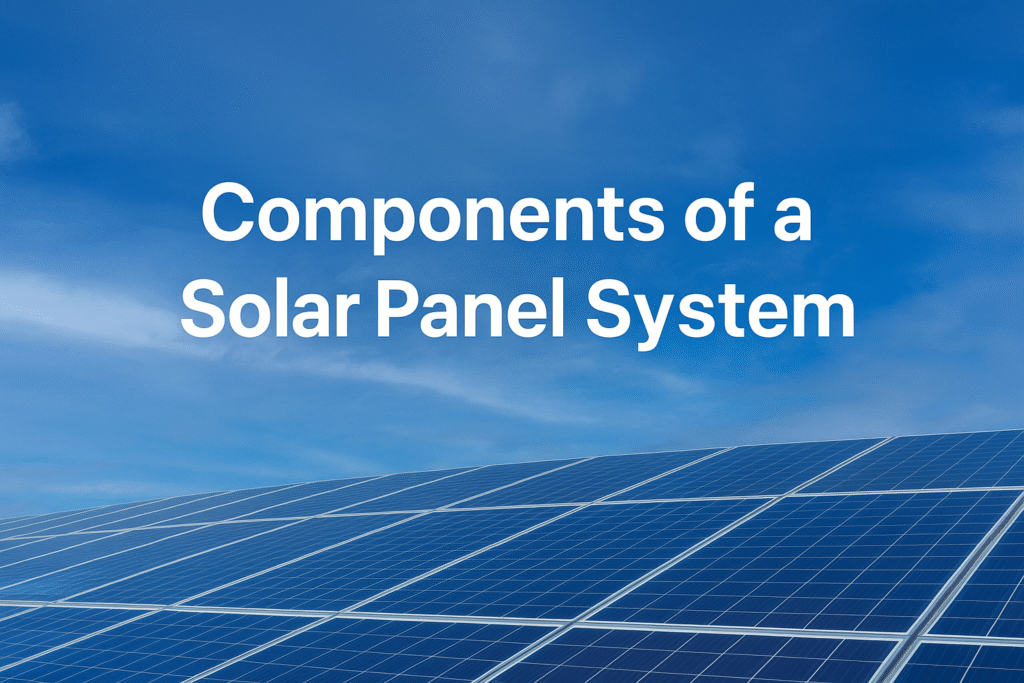How Do Solar Panels Work and Light Up Our Lives?

How Do Solar Panels Work? That’s a great question, and one that many people are asking as our world increasingly looks for cleaner, greener ways to power our homes and businesses. It’s truly amazing how a simple-looking panel can capture the immense power of the sun and turn it into something we can use to run our lights, TVs, and even charge our phones.
This article will help to pull back the curtain and show you exactly, step-by-step, how these incredible devices take sunlight and make it into the electricity that powers our modern lives. Indeed, understanding this process can help us appreciate the magic of renewable energy even more.
What Are Solar Panels?
First off, let’s talk about what solar panels actually are. In simple terms, solar panels are special devices that are designed to capture sunlight and turn it into electricity. Think of them as giant sponges for sunshine! They play a super important role in what we call “renewable energy,” which means energy that comes from sources that won’t run out, like the sun, wind, and water. Unlike burning fossil fuels, which hurt our planet, solar energy is clean and helps keep our air fresh.

The real heart of a solar panel is something called a photovoltaic (PV) cell. These tiny, mighty cells are what actually do the hard work of converting sunlight into electricity. Many PV cells are put together to make one big solar panel. Most of these PV cells are made from a material called silicon, which is a very common element found in sand. Companies like SunPower are well-known for making high-quality solar panels with these efficient cells.
Moreover, the Union of Concerned Scientists and Environment America both strongly support the use of solar panels as a key part of our energy future.
The growth of solar energy globally has been truly remarkable. In 2024, global solar PV installations set another record, reaching nearly 600 GW, a 33% increase over 2023. This rapid expansion shows just how much the world is embracing this clean energy source.
| Year | Global Solar PV Installations (GW) | Growth from Previous Year |
|---|---|---|
| 2023 | ~450 | 85% |
| 2024 | ~600 | 33% |
Source: SolarPower Europe, 2025 Global Market Outlook
Step-by-Step Process: How Do Solar Panels Work?
Now, let’s get into the nitty-gritty of how do solar panels work by breaking down the process into easy steps. It’s like a magical dance between the sun and the panel!
Step 1: Sunlight Hits the Solar Panel
The whole process kicks off when sunlight shines down on the solar panel. Sunlight isn’t just a big, bright light; it’s made up of tiny packets of energy called photons. Think of photons as little energy bullets flying through space.

When these photons from the sun hit the surface of a solar panel, they are absorbed by the PV cells inside. Environment America, SunSave, and EnergySage all emphasise that the absorption of photons is the crucial first step in generating solar electricity.
Step 2: Generation of Electric Current
This is where the real magic of the photovoltaic effect happens. When the photons from the sun are absorbed by the silicon material in the PV cells, they give a little jolt of energy to the electrons inside. These electrons, which are tiny, tiny parts of an atom, get so excited that they break free from their usual spots. Because of the special way the silicon is put together, these freed electrons are pushed to move in a certain direction, creating a flow of electricity.
This flow of electrons is what we call an electric current. EnergySage, Environment America, and The Union of Concerned Scientists all explain this process in detail, highlighting the clever design of PV cells.
This constant drive for better performance has led to significant improvements in solar panel efficiency over time. Modern solar panels can achieve efficiencies of up to 22.8%, with the average now sitting comfortably between 19-22%. This is a huge leap from early solar cells, which often had efficiencies of just 1-2%.
| Era | Typical Solar Panel Efficiency |
|---|---|
| Early Solar Cells | 1-6% |
| Modern Residential Panels | 18-24% |
| Leading-Edge Panels | Up to 24.1% |
Source: Sunsave, RatedPower, 2025
Step 3: Conversion of DC to AC
The electricity that comes directly out of a solar panel is called direct current (DC). Imagine a steady, one-way flow of water. However, most of the appliances in our homes, like our refrigerators, lights, and TVs, use a different kind of electricity called alternating current (AC). Think of AC as water flowing back and forth. Therefore, we need a special device to change the DC electricity from the solar panels into AC electricity.
This important job is done by something called an inverter. The inverter acts like a translator, making sure the electricity is in the right language for your home. Companies like Heatable often provide detailed information about how inverters work.
Step 4: Distribution of Electricity
Once the electricity has been converted from DC to AC by the inverter, it’s ready to power your home! This clean, solar-generated electricity now flows through your home’s electrical system, turning on your lights, running your dishwasher, and charging all your gadgets. But what happens if your solar panels make more electricity than your home needs at that moment?
That extra electricity doesn’t just disappear! It can actually be sent back to the main power grid, which is the big network of electricity lines that powers entire neighbourhoods and cities.
When you send electricity back to the grid, you often get a credit on your electricity bill. EcoWatch, Ossila, NoBrokerHood, EnergySage, and SunSave all discuss how this grid interaction works and the benefits of net metering.
The worldwide shift towards solar power is evident in adoption rates. For instance, China alone installed an impressive 329 GW in 2024, accounting for 55% of global additions and truly leading the charge in solar deployment. Many other countries are also seeing significant growth, reflecting a global commitment to renewable energy.
| Country | Solar PV Capacity (GW, as of 2022/2023 est.) | Percentage of Global Capacity |
|---|---|---|
| China | 390 GW | ~37% |
| United States | 113 GW | ~10.7% |
| Japan | 83 GW | ~7.7% |
| India | 63 GW | ~7.2% |
Source: Sunsave, Wikipedia, 2025
Step 5: Storage of Excess Energy
Sometimes, you might want to save that extra electricity for later, especially if the sun isn’t shining, like at night or on a very cloudy day. This is where battery storage comes in handy. You can install special batteries in your home that can store the excess electricity generated by your solar panels. These batteries are like big energy savings accounts. Then, when your solar panels aren’t producing enough electricity, you can use the power stored in your batteries instead of relying on the main power grid. This gives you even more energy independence.
Components of a Solar Panel System
To really understand how do solar panels work, it’s helpful to know about all the different parts that make up a complete solar energy system.

PV Cells: As we mentioned, these are the tiny, light-absorbing powerhouses. They are made of special materials, most commonly silicon, which have unique properties that allow them to create an electric current when hit by sunlight. Each PV cell produces only a small amount of electricity, so many are connected together to form a solar panel.
Inverter: This crucial device transforms the DC electricity from the solar panels into AC electricity suitable for your home. There are different types of inverters, such as string inverters (where all panels are connected to one inverter), micro-inverters (where each panel has its own small inverter), and hybrid inverters (which can manage both solar production and Solar battery storage).
Mounting System: Solar panels don’t just float in the air! They need a strong and secure mounting system to hold them in place, usually on your roof or on the ground. This system ensures the panels are angled correctly to catch the most sunlight throughout the day and are safe from strong winds or other weather conditions.
Battery Storage: While optional, batteries are a fantastic addition to a solar system. They store excess energy produced during sunny periods, making it available when the sun isn’t shining. This means you can power your home with solar energy even at night, increasing your energy independence. Time and SunSave often cover the latest advancements in battery storage technology.
Factors Affecting Solar Panel Efficiency
Even though solar panels are super smart, a few things can influence just how well do solar panels work.
Location: Where you live makes a big difference! Sunny places with lots of clear days will naturally get more out of their solar panels than places that are often cloudy or have short daylight hours. The amount of direct sunlight a location receives plays a huge role.
Angle and Orientation: Think about how you would hold a mirror to catch the most sun. Solar panels are similar! They need to be tilted at the right angle and facing the right direction (usually south in the Northern Hemisphere) to soak up as much sunlight as possible throughout the day. A well-designed mounting system helps achieve this.
Maintenance: Just like anything else, a little bit of care can go a long way. Keeping your solar panels clean from dirt, dust, leaves, or snow ensures that sunlight can reach them without any blockage. Regular check-ups by a professional can also make sure everything is working smoothly. Wikipedia, Homebuilding, and the Union of Concerned Scientists all provide helpful information on solar panel maintenance.
Benefits of Using Solar Panels
Beyond understanding how do solar panels work, it’s crucial to grasp the tangible benefits they offer. One of the most compelling aspects is the dramatic reduction in cost. The cost of solar energy has dropped by an astonishing 89% since 2010, making it one of the most affordable power generation technologies available today. This makes solar a smart financial decision for many.
| Metric | Cost Reduction (Since 2010) |
|---|---|
| Solar Energy LCOE (per kWh) | 89% decrease |
| Solar Panel Prices | Over 60% decrease (last decade) |
| Solar Battery Storage | 72% decrease (since 2015) |
Source: IRENA, Enkonn Solar, 2025
Now that we know how do solar panels work, let’s talk about why they are such a great idea!
Cost Savings: One of the biggest reasons people switch to solar is to save money! Once your solar panels are installed, you’ll be producing your own electricity, which means you’ll buy less from the utility company. Over time, this can lead to significant savings on your electricity bills. The Scottish Sun and Investopedia often report on the financial benefits of solar energy.
Environmental Impact: This is a huge one! Solar panels produce clean electricity without burning fossil fuels, which release harmful pollution into the air. By using solar energy, you’re helping to reduce your carbon footprint, fight climate change, and keep our planet healthier for everyone.
When considering how solar panels work for the environment, the impact is undeniably positive. While there’s a carbon footprint associated with manufacturing solar panels, this is quickly offset once they’re operational. Solar panels can reduce carbon emissions by a significant margin. For every kilowatt-hour of electricity generated, rooftop solar panels emit around 41 grams of CO2 equivalent emissions, which is roughly 12 times less than natural gas and 20 times less than coal-generated electricity. Most panels offset their manufacturing emissions within their first three years of operation, leaving decades of clean power.
| Energy Source | Lifecycle CO2 Emissions (g CO2e/kWh) |
|---|---|
| Coal | 820 |
| Natural Gas | 490 |
| Rooftop Solar PV | 41 |
Energy Independence: Imagine not having to worry as much about power outages or rising electricity prices from the big utility companies. With solar panels, you’re generating your own power, giving you more control over your energy supply. This can provide a sense of security and freedom.
Common Misconceptions
There are a few common ideas about solar panels that aren’t quite right. Let’s clear them up!
Weather Dependency: Many people think solar panels only work on perfectly sunny days. While direct sunlight is best, solar panels can still generate electricity on cloudy or overcast days. They just might not produce as much. Even on rainy days, some light still gets through!
Maintenance Requirements: Some worry that solar panels need constant cleaning and fixing. In reality, solar panels are quite durable and require very little maintenance. Rain often helps to wash them clean, and occasional checks are usually all that’s needed.
Initial Costs: It’s true that installing solar panels can be an upfront investment. However, the costs have come down a lot in recent years, and there are often government incentives, tax credits, and financing options available that can make solar energy much more affordable than you might think. These incentives are designed to encourage more people to switch to clean energy.
Conclusion
In conclusion, understanding how do solar panels work reveals a truly elegant and impactful process. From the moment sunlight’s tiny photons strike a photovoltaic cell, an incredible transformation begins, ultimately delivering clean, usable electricity right to our homes.
We’ve seen how solar panels capture sunlight, generate an electric current, convert it to the right type of power, and even store it for later use. Beyond the technical aspects, the benefits are clear: significant cost savings on electricity bills, a powerful reduction in our environmental footprint, and a liberating step towards greater energy independence.
If you’ve ever considered harnessing the sun’s power, now is an excellent time to explore the options available. Take the next step and investigate how solar energy can illuminate your life and contribute to a brighter, cleaner future for all.
Thanks for reading the Guide. You can check out the Momentum Solar Pyramid Scheme
FAQs
Yes, solar panels can still generate some electricity on cloudy or rainy days, though not as much as on bright, sunny days. They use daylight, not just direct sunshine.
Most solar panels are built to last a very long time, typically 25 to 30 years or even more. They are designed to withstand various weather conditions.
Excess energy can be sent back to the main power grid, often earning you credits on your electricity bill (this is called net metering). Alternatively, it can be stored in batteries for later use, especially at night or during power outages.
No, solar panels generally require very little maintenance. Rain often washes them clean, and occasional checks for debris or dirt are usually sufficient.
Yes, many governments and local authorities offer various incentives, such as tax credits, rebates, or grants, to encourage people to install solar panels. These programs can significantly reduce the initial cost of a solar system.
